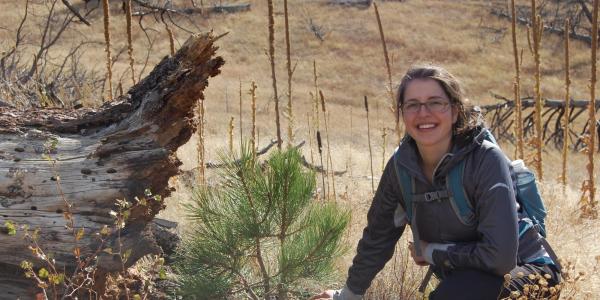Students and faculty alike have new opportunities to engage with Southeast Asia
Southeastern Asia significantly influences world politics, economics and culture, and students at the University of Colorado Boulder will soon enjoy more options to learn about the region.
CU Boulder’s Center for Asian Studies (CAS) is beginning its second year of a federally funded grant project to build a new Southeast Asian Studies (SEA) track for its curricular offerings and programming. Project Director Tim Oakes and Co-Director Danielle Rocheleau Salaz plan to further develop a suite of language courses, content courses, and study abroad opportunities for both faculty and students.
The two-year project is funded by the U.S. Department of Education’s Undergraduate International Studies and Foreign Languages program.
Oakes, a geography professor, directs the center. Salaz is executive director.

Danielle Salaz, executive director of CU Boulder's Center for Asian Studies. Photo by Craig Levinsky. At top of page, image of Bangkok courtesy of Pixabay.
Salaz said the center aims to put Asia “at the center of our students’ studies, so that we’re not just examining Asia from a U.S. perspective and how it impacts foreign policy, but looking at Asia on its own terms and tying together different forces and countries within the continent.”
A student may receive a major or minor degree in Asian studies. But the curriculum requires collaboration from nearly 120 faculty in outside departments who have expertise in Asian content areas, allowing the center to offer a wide range of courses to its student population. The departments offering the most courses (or cross-listed courses) in the Asian studies curriculum are religious studies, Asian languages and civilizations, geography, anthropology and history.
The Center for Asian Studies’ relationships with these departments is reciprocal. The center hosts roughly 40 campus events annually, and many permanent full-time faculty have been placed in departments across the university through “hiring lines” created by CAS grant projects such as this one.
The Southeast Asia Studies area has faculty strengths in Indonesia, but lacks the “curriculum and language component to really call ourselves a complete pan-Asian center,” Salaz said. So, this project is “focused on bolstering the Southeast Asian studies component” of the center.
In addition to Indonesia, the specific territory designated as Southeast Asia includes Burma, Laos, Philippines, Malaysia, Singapore, Thailand and Vietnam.
“Southeast Asia is in the news,” said Salaz. “It’s an active part of the world. We want to make sure we’re arming our students with knowledge about it so that when they graduate they can go out and be successful beyond the borders of campus.”
The CAS grant project has three primary goals. First, it aims to expand the center’s course offerings. To that end, CAS created a course in Southeast Asian environmental politics and hired Instructor Michael Dwyer, who holds a doctorate in energy and resources from the University of California, Berkeley, to the Department of Geography.
As a sub-initiative funded by the project, CAS holds a course-development grant competition to make resources available to faculty interested in developing SEA content for either a new or existing course.
This summer, Chris Hammons of anthropology and Japanese scholar and professor of history Miriam Kingsberg Kadia were both awarded such grants. Hammons created a course in Indonesian state-craft and population protest and resistance, while Kadia developed one on World War II in Southeast Asia, which will examine how Southeast Asian conditions affected Japan, the United States and the war.
The development grants are “a way for us to encourage faculty who have expertise in Asia but might not teach a class about SEA to think about how they can add to the curriculum,” said Salaz.
The second goal of the grant is to establish Directed Independent Language Study (DILS) courses in Southeast Asian languages. DILS is an online teaching model for language instruction first developed at Yale and brought to CU by Mark Knowles, director of CU Boulder’s Anderson Language Technology Center.
The college has offered courses in Tibetan, Nepalese and other languages using DILS. The center’s pilot DILS course will be in Indonesian and taught by Fransiska Turangan, instructor at the Defense Language Institute in Monterey, Calif.
Online instruction is an effective way to offer less-frequently taught languages, Salaz said. “Nobody can consistently support having an instructor teach a class with three or four students under the traditional classroom model.”
DILS is a proven method, she said. “It’ll be synchronous, so the students and instructor will be online at the same time.” Next year, the center plans to offer Burmese or Lao, using the same format.
The final grant goal is to expand study-abroad participation for undergraduates studying Southeast Asian languages and cultures. This initiative details a newly formed exchange program with a Southeast Asia-based university, as well as a faculty-led global seminar in Southeast Asia, to enhance student options in the region. To build the initiative, CAS is offering undergraduate study-abroad scholarships and faculty grants to develop new global seminars in Southeast Asian studies.
“We understand that immersing yourself in a culture and place is significant in understanding anything about it,” said Salaz. CU Boulder has sent an average of seven students a year to Southeast Asia through existing study-abroad programs using outside providers and student-exchange relationships.
“It’s not nothing, but we can bolster that,” Salaz said. This fall, the center will send four students to Thailand, Singapore and Vietnam, all with scholarships funded from the grant.
Although the center requires that majors take courses in a foreign language, its aim is not to steer students who might be interested in Asia down only one path — such as contemporary issues, traditional issues or on art or politics. Clearly, it’s within the center’s mission to encourage students to be active global contributors.
“Whether going with a faculty member to Indonesia or taking a DILS class and learning the language while here,” said Salaz, “we want to make sure that students realize that international engagement is not an unreachable goal, and that whatever they can do while they’re on campus will help situate them for success in their careers and in the future. It just helps to ensure that we have globally engaged and knowledgeable citizens making the right choices on an individual basis and on a national and global scale, as well.”



